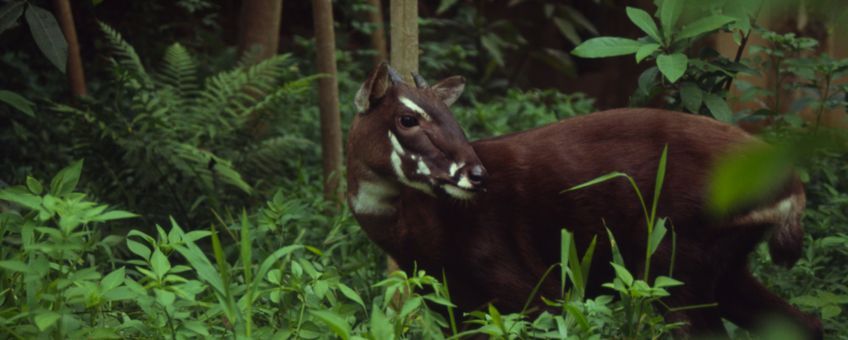
Establishing a conservation breeding programme to save the last saola
Leibniz Institute for Zoo and Wildlife ResearchIn order to save the saola (Pseudoryx nghetinhensis) it is essential to establish a conservation breeding programme. A group of conservationists and conservation scientists, including members of the IUCN Saola Working Group and the Leibniz Institute for Zoo and Wildlife Research Berlin, have voiced their concern about the future of the species and stressed the importance of urgent ex situ management.
Extirpation in the Annamites equates to global extinction
Since its scientific discovery just 25 years ago, the saola has become a flagship for conservation in Southeast Asia. “For many years, the Saola Working Group has worked in collaboration with NGO partners and the governments of Vietnam and Lao PDR to protect the forests and wildlife of the Annamites. But despite the ongoing efforts, there has been little progress in either Vietnam or Lao PDR to reduce the snaring to levels that will allow the last saola to survive,” says William Robichaud, the Coordinator of the Saola Working Group. Because snares kill indiscriminately, populations of all large- and medium-sized mammals in the region have been decimated. While this is a tragedy for all ground-dwelling species, it is a catastrophe for endemics like the saola because their extirpation in the Annamites equates to global extinction. Two other recently-described endemic mammal species in immediate danger are the large-antlered muntjac (Muntiacus vuquangensis) and the Annamite striped rabbit (Nesolagus timminsi).
Last confirmed record dates from 2013
 The saola faces imminent extinction. Although exact population estimates are problematic, in 2015 the Saola Working Group estimated the global population to be less than 100 individuals. The situation has deteriorated considerably since then, and it is likely that the species is down to a few individuals scattered across the region. To deal with this dire situation, the Saola Working Group is working with the governments of Vietnam and Laos PDR to implement a bold new initiative to save the species: establishing a conservation breeding programme. “Capturing some of the last saola and transferring them to a protected breeding facility supervised and staffed by international experts is the most important step to save this enigmatic species from extinction,” says Robichaud. But for conservationists and conservation scientists working on saola conservation, finding and capturing the last saola remains a daunting task. In addition to being very rare, the animal lives in some of the most rugged rainforests on the planet. The last confirmed record of a saola is a photograph obtained through camera-trapping by WWF-Vietnam in 2013 in the Saola Nature Reserves.
The saola faces imminent extinction. Although exact population estimates are problematic, in 2015 the Saola Working Group estimated the global population to be less than 100 individuals. The situation has deteriorated considerably since then, and it is likely that the species is down to a few individuals scattered across the region. To deal with this dire situation, the Saola Working Group is working with the governments of Vietnam and Laos PDR to implement a bold new initiative to save the species: establishing a conservation breeding programme. “Capturing some of the last saola and transferring them to a protected breeding facility supervised and staffed by international experts is the most important step to save this enigmatic species from extinction,” says Robichaud. But for conservationists and conservation scientists working on saola conservation, finding and capturing the last saola remains a daunting task. In addition to being very rare, the animal lives in some of the most rugged rainforests on the planet. The last confirmed record of a saola is a photograph obtained through camera-trapping by WWF-Vietnam in 2013 in the Saola Nature Reserves.
Molecular analysis of terrestrial blood-sucking leeches
“We need more systematic large scale surveys across the Annamite landscape to find the last saola, and the remaining strongholds of other highly threatened species,” explains Andrew Tilker of the Leibniz Institute for Zoo and Wildlife Research in Berlin, Germany, lead author of the letter. Tilker is also a member of the IUCN Saola Working Group and an Associate Conservation Scientist at Global Wildlife Conservation. For the past three years scientists from the Leibniz-IZW, in collaboration with conservationists from WWF and Global Wildlife Conservation, have been surveying mammal communities in the central Annamites mountain range. “Expanding surveys to more areas and coupling established methods such as camera-trapping with modern approaches such as the molecular analysis of terrestrial blood-sucking leeches is needed to find the remaining populations of these threatened endemic mammal species,” Tilker says. “With these data, conservation scientists can make recommendations for the effective use of limited resources to aid the conservation of the rare and threatened Annamite endemics.”
Still a chance
Barney Long, member of the Saola Working Group and Director of Species Conservation at Global Wildlife Conservation, says, “With a collaborative international effort, in partnership with the governments of Vietnam and Lao PDR, we still have a chance to save the saola from extinction. If we can raise the required funding, we believe we can succeed, and the story of the saola will pave the way for similar approaches for other highly threatened species in the Annamites.”
A letter of concern has been published in the scientific journal Science.
Working together to save the saola (Source: WWF)
Text: Leibniz Institute for Zoo and Wildlife Research (IZW-Berlin)
Photos: David Husle, WWF-Global; WWF-Vietnam
